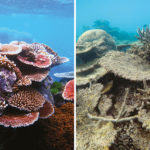
Next time you order a drink on a hot summer day, before quenching your thirst, take a good look inside your glass. Ice floats. Everyone knows that and it’s something we take for granted. But actually, ice shouldn’t float. Every other compound on earth is heavier as a solid than in its liquid form. When you cool down something, it shrinks, becomes denser and it sinks. This is because temperature reflects the speed of molecules. You cool down something, the molecules start moving slower, take up less space and the compound starts to shrink. That’s the way nature should behave. Right?
 So why is water any different? Actually, water also follows this rule, but only up to a specific point. You cool down water, it starts to become denser and it sinks. That’s why we encounter thermoclines while we’re diving: The colder, heavier water stays below the warmer, lighter water on top. Now, when the temperature reaches 4°C, something strange happens and water starts to expand again (Figure 1). The ice cold water starts to float to the surface, where at 0°C a layer of ice starts to form.
So why is water any different? Actually, water also follows this rule, but only up to a specific point. You cool down water, it starts to become denser and it sinks. That’s why we encounter thermoclines while we’re diving: The colder, heavier water stays below the warmer, lighter water on top. Now, when the temperature reaches 4°C, something strange happens and water starts to expand again (Figure 1). The ice cold water starts to float to the surface, where at 0°C a layer of ice starts to form.
This is where it starts getting interesting. This layer of ice at the surface act as a layer of insulation for what’s down below. It protects the aquatic organisms from the cold and prevents the body of water from freezing completely. Can you imagine what the ocean – and life on earth – would look like if water would behave like any other substance on earth? The ocean would freeze from the bottom and all life on the ocean floor would no longer find protection or food. Also the layer of ice at the bottom wouldn’t insulate the water on top, so nothing would prevent the ocean from freezing entirely – in cold regions of course. In short, the whole place would be pretty much inhospitable for life!
Some scientists claim life on our planet originated under and in the ice, so in fact, none of us would be here if water would stick to the rules.
See? I guess, not always sticking to the rules can have a great outcome sometimes!









